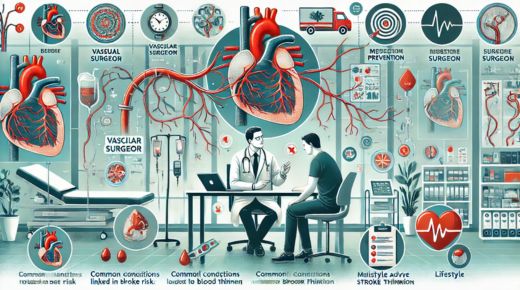
Vascular surgeons play a crucial role in preventing strokes. They focus on the health of blood vessels and arteries. This can help reduce the risk of strokes, including cases like “coldwater stroke.” Their work can make a big difference in keeping our brains healthy. Understanding how they do this can help us appreciate the importance of vascular health. Let’s explore how these surgeons contribute to stroke prevention.
Understanding Vascular Health
The circulatory system is like the body’s highway. Blood vessels carry oxygen and nutrients to every part of the body. If these vessels narrow or become blocked, it can lead to serious issues, such as strokes. Vascular surgeons work to ensure that these pathways remain open and functioning well.
Procedures and Techniques
Vascular surgeons use a range of procedures to maintain and improve blood flow. These include:
- Angioplasty: This technique involves inflating a small balloon inside a narrowed blood vessel to widen it.
- Stenting: Inserting a small mesh tube to keep the vessel open after angioplasty.
- Carotid endarterectomy: Removing plaque from the carotid artery to prevent strokes.
These procedures help reduce the risk of stroke by improving blood flow and preventing blockage.
Identifying Stroke Risks
Vascular surgeons also assess stroke risk factors. They evaluate:
- High blood pressure: This puts extra strain on blood vessels.
- Diabetes: Increases risk due to potential damage to blood vessels.
- High cholesterol: Leads to plaque buildup in arteries.
By addressing these factors, they help reduce the likelihood of stroke.
Comparing Surgical and Non-Surgical Approaches
It’s important to understand the difference between surgical and non-surgical methods in stroke prevention. The table below highlights these approaches:
| Approach | Examples | Purpose |
| Surgical | Angioplasty, Stenting, Carotid endarterectomy | To physically open or clear blood vessels |
| Non-Surgical | Medication, Lifestyle changes, Regular monitoring | To manage blood pressure and cholesterol |
Preventive Measures at Home
While vascular surgeons perform critical procedures, there are steps everyone can take to reduce stroke risk:
- Healthy diet: Eating fruits, vegetables, and whole grains supports vascular health.
- Regular exercise: Keeps blood vessels flexible and reduces blood pressure.
- No smoking: Smoking damages blood vessels and raises stroke risk.
These lifestyle changes can complement medical care and improve overall health.
When to Consult a Vascular Surgeon
Seeing a vascular surgeon might be necessary if there are symptoms like:
- Persistent leg pain during walking
- Sudden weakness or numbness in limbs
- Changes in skin color or temperature in extremities
Early consultation can lead to better outcomes and prevent serious complications. For more information on when to seek medical advice, visit the National Heart, Lung, and Blood Institute.
Conclusion
Vascular surgeons are key players in stroke prevention. Through surgical and lifestyle interventions, they help maintain vessel health and reduce risks. By understanding their role, we can make informed choices about our health and seek timely care when necessary. Implementing preventive measures at home can further safeguard against stroke. Together with medical professionals, we can strive for healthier lives.